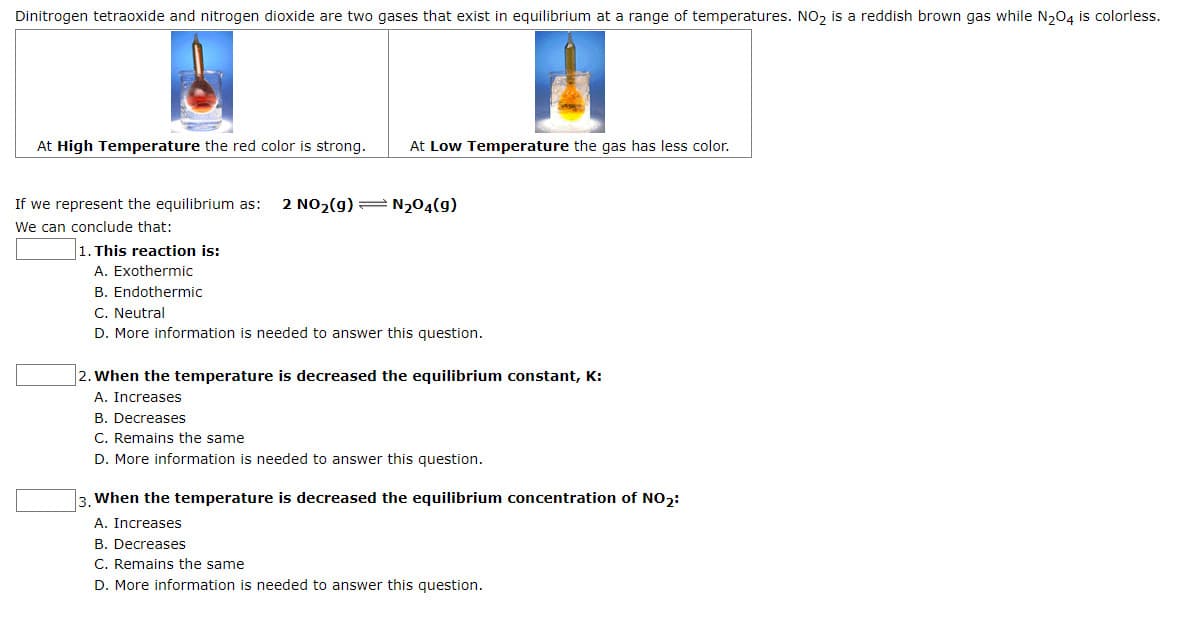Dinitrogen tetraoxide and nitrogen dioxide are two gases that exist in equilibrium at a range of temperatures. NO2 is a reddish brown gas while N204 is co At High Temperature the red color is strong. At Low Temperature the gas has less color. If we represent the equilibrium as: 2 NO2(g) = N204(g) We can conclude that: 1. This reaction is: A. Exothermic B. Endothermic C. Neutral D. More information is needed to answer this question. 2. When the temperature is decreased the equilibrium constant, K: A. Increases B. Decreases C. Remains the same D. More information is needed to answer this question. 3. When the temperature is decreased the equilibrium concentration of NO2: A. Increases B. Decreases C. Remains the same D. More information is needed to answer this question.
Dinitrogen tetraoxide and nitrogen dioxide are two gases that exist in equilibrium at a range of temperatures. NO2 is a reddish brown gas while N204 is co At High Temperature the red color is strong. At Low Temperature the gas has less color. If we represent the equilibrium as: 2 NO2(g) = N204(g) We can conclude that: 1. This reaction is: A. Exothermic B. Endothermic C. Neutral D. More information is needed to answer this question. 2. When the temperature is decreased the equilibrium constant, K: A. Increases B. Decreases C. Remains the same D. More information is needed to answer this question. 3. When the temperature is decreased the equilibrium concentration of NO2: A. Increases B. Decreases C. Remains the same D. More information is needed to answer this question.
Chemistry for Engineering Students
4th Edition
ISBN:9781337398909
Author:Lawrence S. Brown, Tom Holme
Publisher:Lawrence S. Brown, Tom Holme
Chapter12: Chemical Equilibrium
Section: Chapter Questions
Problem 12.101PAE: 12.101 An engineer working on a design to extract petroleum from a deep thermal reservoir wishes to...
Related questions
Question

Transcribed Image Text:Dinitrogen tetraoxide and nitrogen dioxide are two gases that exist in equilibrium at a range of temperatures. NO2 is a reddish brown gas while N204 is colorless.
At High Temperature the red color is strong.
At Low Temperature the gas has less color.
If we represent the equilibrium as:
2 NO2(g) =N204(g)
We can conclude that:
1. This reaction is:
A. Exothermic
B. Endothermic
C. Neutral
D. More information is needed to answer this question.
2. When the temperature is decreased the equilibrium constant, K:
A. Increases
B. Decreases
C. Remains the same
D. More information is needed to answer this question.
3. When the temperature is decreased the equilibrium concentration of NO,:
A. Increases
B. Decreases
C. Remains the same
D. More information is needed to answer this question.
Expert Solution
This question has been solved!
Explore an expertly crafted, step-by-step solution for a thorough understanding of key concepts.
Step by step
Solved in 2 steps with 2 images

Knowledge Booster
Learn more about
Need a deep-dive on the concept behind this application? Look no further. Learn more about this topic, chemistry and related others by exploring similar questions and additional content below.Recommended textbooks for you

Chemistry for Engineering Students
Chemistry
ISBN:
9781337398909
Author:
Lawrence S. Brown, Tom Holme
Publisher:
Cengage Learning

General Chemistry - Standalone book (MindTap Cour…
Chemistry
ISBN:
9781305580343
Author:
Steven D. Gammon, Ebbing, Darrell Ebbing, Steven D., Darrell; Gammon, Darrell Ebbing; Steven D. Gammon, Darrell D.; Gammon, Ebbing; Steven D. Gammon; Darrell
Publisher:
Cengage Learning

Introductory Chemistry: A Foundation
Chemistry
ISBN:
9781337399425
Author:
Steven S. Zumdahl, Donald J. DeCoste
Publisher:
Cengage Learning

Chemistry for Engineering Students
Chemistry
ISBN:
9781337398909
Author:
Lawrence S. Brown, Tom Holme
Publisher:
Cengage Learning

General Chemistry - Standalone book (MindTap Cour…
Chemistry
ISBN:
9781305580343
Author:
Steven D. Gammon, Ebbing, Darrell Ebbing, Steven D., Darrell; Gammon, Darrell Ebbing; Steven D. Gammon, Darrell D.; Gammon, Ebbing; Steven D. Gammon; Darrell
Publisher:
Cengage Learning

Introductory Chemistry: A Foundation
Chemistry
ISBN:
9781337399425
Author:
Steven S. Zumdahl, Donald J. DeCoste
Publisher:
Cengage Learning

Chemistry: An Atoms First Approach
Chemistry
ISBN:
9781305079243
Author:
Steven S. Zumdahl, Susan A. Zumdahl
Publisher:
Cengage Learning

Chemistry
Chemistry
ISBN:
9781305957404
Author:
Steven S. Zumdahl, Susan A. Zumdahl, Donald J. DeCoste
Publisher:
Cengage Learning
